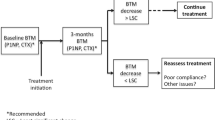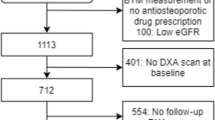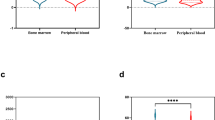Abstract
This cross-sectional study evaluated the distribution of serum cross-linked C-telopeptides of collagen type I (βCTXs) in postmenopausal women, the characteristics of bone remodeling, and the factors influencing this bone marker, especially the use of anti-osteoporotic drugs. Women (n = 4,175) aged 59–70 years randomly selected from the community were invited to participate, measuring βCTXs and lumbar and femoral bone mineral density at recruitment. Risk factors for osteoporosis and the use of anti-osteoporotic treatment were collected with a structured questionnaire. We evaluated the percentage of women with increased (βCTXs >0.620 ng/mL) and decreased bone turnover (βCTXs <0.100 ng/mL) and those reaching the so-called treatment target (values of βCTXs within the lower half of the reference range for healthy young premenopausal women). Two thousand nine hundred sixty-eight women (70 %) participated (2,405 non-treated and 563 treated). Increased and decreased bone turnover was observed in 16.4 and 1.8 %, respectively, of non-treated women with significant differences compared with treated women (9.7 and 14.2 %, respectively, p < 0.001); 28 % of non-treated osteoporotic individuals had increased bone turnover versus 14 % of osteopenic participants and 8.8 % of women with normal bone density (p < 0.001). Women receiving bisphosphonates presented the highest percentages of decreased bone turnover (27 %) and βCTXs (43 %) within the treatment target. Increased bone turnover is observed in 16.4 % of non-treated postmenopausal women and is more frequent in individuals with osteoporosis, whereas decreased bone turnover is unusual. Most participants taking bisphosphonates had values within the treatment target, but nearly one quarter had decreased bone turnover.


Similar content being viewed by others
References
Vasikaran S, Eastell R, Bruyère O, Foldes AJ, Garnero P, Griesmacher A, IOF-IFCC Bone Marker Standards Working Group et al (2011) Markers of bone turnover for the prediction of fracture risk and monitoring of osteoporosis treatment: a need for international reference standards. Osteoporos Int 22:391–420
Civitelli R, Armamento-Villarreal R, Napoli M (2009) Bone turnover markers: understanding their value in clinical trials and clinical practice. Osteoporos Int 20:843–851
Ivaska KK, Gerdhem P, Väänänen HK, Akesson K, Obrant KJ (2010) Bone turnover markers and prediction of fracture: a prospective follow-up study of 1040 elderly women for a mean of nine years. J Bone Miner Res 25:393–403
Garnero P, Sornay-Rendu E, Claustrat B, Delmas PD (2000) Biochemical markers of bone turnover, endogenous hormones and the risk of fractures in postmenopausal women: the OFELY study. J Bone Miner Res 15:1526–1536
Miller PD (2007) Monitoring osteoporosis therapy. Curr Osteoporos Rep 5:38–43
Lewiecki EM (2010) Benefits and limitations of bone mineral density and bone turnover markers to monitor patients treated for osteoporosis. Curr Osteoporos Rep 8:15–22
Bergmann P, Body JJ, Boonen S, Boutsen Y, Devogelaer JP, Goemaere S, Kaufman JM, Reginster JY, Gangji V, Members of Advisory Board on Bone Markers, (2009) Evidence-based guidelines for the use of biochemical markers of bone turnover in the selection and monitoring of bisphosphonate treatment in osteoporosis: a consensus document of the Belgian Bone Club. Int J Clin Pract 63:19–26
Glover SJ, Garnero P, Naylor K, Rogers A, Eastell R (2008) Establishing a reference range for bone turnover markers in young, healthy women. Bone 42:623–630
Glover SJ, Gall M, Schoenborn-Kellenberger O, Wagener M, Garnero P, Boonen S, Cauley JA, Black DM, Delmas PD, Eastell R (2009) Establishing a reference interval for bone turnover markers in 637 healthy, young, premenopausal women from the United Kingdom, France, Belgium, and the United States. J Bone Miner Res 24:389–397
Karsdal MA, Qvist P, Christiansen C, Tankó LB (2006) Optimising antiresorptive therapies in postmenopausal women: why do we need to give due consideration to the degree of suppression? Drugs 66:1909–1918
Visekruna M, Wilson D, McKiernan FE (2008) Severely suppressed bone turnover and atypical skeletal fragility. J Clin Endocrinol Metab 93:2948–2952
Epstein S (2005) The roles of bone mineral density, bone turnover, and other properties in reducing fracture risk during antiresorptive therapy. Mayo Clin Proc 80:379–388
Compston J (2007) Over-suppression of bone turnover: does it exist? Curr Osteoporos Rep 5:179–185
Kanterewicz E, Puigoriol E, Peris P, Del Río L, Rosique P, Yáñez A, Grupo de investigadores del estudio de Fracturas Osteoporóticas de Osona (2009) Relationship between C-telopeptides of type I collagen serum values with bone mineral density and antiosteoporotic drug intake in postmenopausal women. Preliminary data from the FRODOS study. Med Clin (Barc) 133:609–614
Kanterewicz E, Peris P, Puigoriol E (2011) Prevalence of densitometric osteoporosis and osteopenia in Spain. Bone 48:667
Martínez J, Olmos JM, Hernández JL, Pinedo G, Llorca J, Obregón E, Valero C, González-Macías J (2009) Bone turnover markers in Spanish postmenopausal women: the Camargo cohort study. Clin Chim Acta 409:70–74
Gerdhem P, Ivaska KK, Alatalo S, Halleen JM, Hellman J, Isaksson A et al (2004) Bichemical markers of bone metabolism and prediction of fracture in elderly women. J Bone Miner Res 19:386–393
Levey AS, Coresh J, Greene T, Stevens LA, Zhang YL, Hendriksen S et al (2006) Using standardized serum creatinine values in the modification of diet in renal disease study equation for estimating glomerular filtration rate. Ann Intern Med 145:247–254
Woitge HW, Pecherstorfer M, Li Y, Keck AV, Horn E, Ziegler R, Seibel MJ (1999) Novel serum markers of bone resorption: clinical assessment and comparison with established urinary indices. J Bone Miner Res 14:792–801
Luz Rentero M, Carbonell C, Casillas M, González Béjar M, Berenguer R (2008) Risk factors for osteoporosis and fractures in postmenopausal women between 50 and 65 years of age in a primary care setting in Spain: a questionnaire. Open Rheumatol J 2:58–63
Langsetmo LA, Morin S, Richards JB, Davison KS, Olszynski WP, Prior JC, Josse R, Goltzman D, CaMos Research Group (2009) Effectiveness of antiresorptives for the prevention of nonvertebral low-trauma fractures in a population-based cohort of women. Osteoporos Int 20:283–290
Rohr CI, Sarkar A, Barber KR, Clements JM (2004) Prevalence of prevention and treatment modalities used in populations at risk of osteoporosis. J Am Osteopath Assoc 104:281–287
Minisola S, Del Fiacco R, Piemonte S, Iorio M, Mascia ML, Fidanza F et al (2008) Biochemical markers in glucocorticoid-induced osteoporosis. J Endocrinol Invest 31(7 Suppl):28–32
Reyes-García R, Rozas-Moreno P, López-Gallardo G, García-Martín A, Varsavsky M, Avilés-Perez MD, Muñoz-Torres M (2011) Serum levels of bone resorption markers are decreased in patients with type 2 diabetes. Acta Diabetol. doi:10.1007/s00592-011-0347-0
Cadarette SM, Katz JN, Brookhart MA, Stürmer T, Stedman MR, Solomon DH (2008) Relative effectiveness of osteoporosis drugs for preventing nonvertebral fracture. Ann Intern Med 148:637–646
Eisman J, Clapham S, Kehoe L (2004) Osteoporosis prevalence and levels of treatment in primary care: the Australian Bone Care Study. J Bone Miner Res 19:1969–1975
Ettinger B, Barrett-Connor E, Hoq LA, Vader JP, Dubois RW (2006) When is it appropriate to prescribe postmenopausal hormone therapy? Menopause 13:404–410
Eekman DA, Bultink IE, Heijboer AC, Dijkmans BA, Lems WF (2011) Bone turnover is adequately suppressed in osteoporotic patients treated with bisphosphonates in daily practice. BMC Musculoskelet Disord 12:167
Peris P, Torra M, Olivares V, Reyes R, Monegal A, Martínez-Ferrer A, Guañabens N (2011) Prolonged bisphosphonate release after treatment in women with osteoporosis. Relationship with bone turnover. Bone 49:706–709
Johnston CC Jr, Bjarnason NH, Cohen FJ, Shah A, Lindsay R, Mitlak BH et al (2000) Long-term effects of raloxifene on bone mineral density, bone turnover, and serum lipid levels in early postmenopausal women: three-year data from 2 double-blind, randomized, placebo-controlled trials. Arch Intern Med 160:3444–3450
Delmas PD, Davis SR, Hensen J, Adami S, van Os S, Nijland EA (2008) Effects of tibolone and raloxifene on bone mineral density in osteopenic postmenopausal women. Osteoporos Int 19:1153–1160
Landfeldt E, Ström O, Robbins S, Borgström F (2012) Adherence to treatment of primary osteoporosis and its association to fractures—the Swedish Adherence Register Analysis (SARA). Osteoporos Int 23:433–443
Rogers A, Glover SJ, Eastell R (2009) A randomised, double-blinded, placebo-controlled, trial to determine the individual response in bone turnover markers to lasofoxifene therapy. Bone 45:1044–1052
Thomas SD, Need AG, Nordin BE (2010) Suppression of C-terminal telopeptide in hypovitaminosis D requires calcium as well as vitamin D. Calcif Tissue Int 86:367–374
Kruger MC, Schollum LM, Kuhn-Sherlock B, Hestiantoro A, Wijanto P, Li-Yu J, Agdeppa I, Todd JM, Eastell R (2010) The effect of a fortified milk drink on vitamin D status and bone turnover in post-menopausal women from South East Asia. Bone 46:759–767
Rosen CJ, Hochberg MC, Bonnick SL, McClung M, Miller P, Broy S, Kagan R, Chen E, Petruschke RA, Thompson DE, de Papp AE, Fosamax Actonel Comparison Trial Investigators (2005) Treatment with once-weekly alendronate 70 mg compared with once-weekly risedronate 35 mg in women with postmenopausal osteoporosis: a randomized double-blind study. J Bone Miner Res 20:141–151
Berecki-Gisolf J, Hochey R, Dobson A (2008) Adherence to bisphosphonate treatment by elderly women. Menopause 15:984–990
Looker AC, Bauer DC, Chesnut CH III, Gundberg CM, Hochberg MC, Klee G et al (2000) Clinical use of biochemical markers of bone remodelling: current status and future directions. Osteoporos Int 11:467–480
Melton LJ III, Khosla S, Atkinson EJ, O’Fallon WM, Riggs BL (1997) Relationship of bone turnover to bone density and fractures. J Bone Miner Res 12:1083–1091
Delmas PD, Munoz F, Black DM, Cosman F, Boonen S, Watts NB, Kendler D, Eriksen EF, Mesenbrink PG, Eastell R, HORIZON-PFT Research Group (2009) Effects of yearly zoledronic acid 5 mg on bone turnover markers and relation of PINP with fracture reduction in postmenopausal women with osteoporosis. J Bone Miner Res 24:1544–1551
Acknowledgments
This study was supported by a grant (PI05/1430) from the Spanish “Ministerio de Ciencia e Innovación, Instituto de Salud Carlos III”. Roche Diagnostics kindly provided reagents to determine βCTXs.
Conflict of interest
All authors have no conflicts of interest.
Author information
Authors and Affiliations
Consortia
Corresponding author
Additional information
Members of the FRODOS Research Group are given in Appendix.
Appendix: FRODOS Research Group
Appendix: FRODOS Research Group
Dr. Toni Iruela (EAP Centelles), Dr. Xavier Farrés (EAP Vic Sud), Dr. Sara Martínez (CAP Osona), Dr. Maria Vilamú (CAP Manlleu), Dr. Consol Sánchez (CAP Torelló), Dr. Núria de la Iglesia (Consultori Local St Vicenç de Torelló), Dr. Josep Fontarnau (Consultori Local St Pere de Torelló), Dr. Vicenç Canal (CAP Roda de Ter), Dr. Xavier Costa (CAP Tona), Dr. Vicenç Coma (Consultori Local Seva), Dr. Assumpta Farràs (Consultori Local St Miquel de Balenyà), Dr. Lourdes Piñol (CAP St Hipolit de Voltregà), Dr. Rosa Maria Salla (CAP Sta Eugenia de Berga),
Dr. Anna Puente (Consultori Local Taradell), Dr. Marta Cantero (Consultori Local St Julià de Vilatorta), Dr. Carles Blay (Consultori Local Calldetenes), Dr. Anna Ribas (Consultori Local Folgueroles), Dr. Jordi Espinàs (Consultori Local Viladrau), Jordi Oliva (CAP Sta Eugenia de Berga), Dr. Tomàs Morelló (CAP St Quirze de Besora), Dr. Anna Ramos (CAP St Quirze de Besora), Dr. Pere Munt (Consultori de Montesquiu), Dr. Dani Montanyà (Consultori St Boi de Lluçanès), Dr. Josep Mª Garcia Talavera (CAP Prats de Lluçanès), Dr. Raimon Codina (CAP Prats de Lluçanès), Dr. Francesc Olivé (Consultori d’Olost), Dr. Miquel Casadevall (Consultori St Bartomeu del Grau), Judit Solà (Epidemiology Unit-Consorci Hospitalari de Vic).
About this article
Cite this article
Kanterewicz, E., Peris, P., Puigoriol, E. et al. Distribution of serum βCTX in a population-based study of postmenopausal women taking into account different anti-osteoporotic therapies (the FRODOS Cohort). J Bone Miner Metab 31, 231–239 (2013). https://doi.org/10.1007/s00774-012-0410-0
Received:
Accepted:
Published:
Issue Date:
DOI: https://doi.org/10.1007/s00774-012-0410-0




